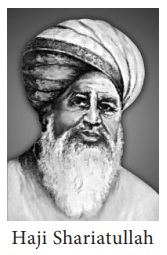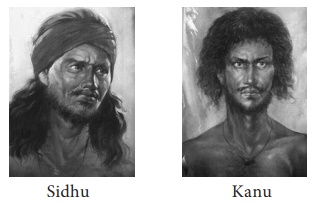Anti-Colonial Movements and the Birth of Nationalism | India - Peasant and Tribal Resistance | 10th Social Science : History : Chapter 7 : Anti-Colonial Movements and the Birth of Nationalism
Chapter: 10th Social Science : History : Chapter 7 : Anti-Colonial Movements and the Birth of Nationalism
Peasant and Tribal Resistance
Peasant and Tribal Resistance
While the urban elite of India was busy responding to the western ideas and rationality by engaging in various socio-religious reform movements, a far more aggressive response to the British rule emerged in rural India. The traditional elite and peasantry along with the tribals revolted. They were not necessarily seeking the removal of British but rather the restoration of the pre-colonial order.
There
were nearly a hundred peasant uprisings during British rule. They can be
classified into the following categories:
a. Restorative
rebellions – Agitation of this type relates to attempts to restore old order and old social
relations.
b. Religious
Movements – Such agitations
were led by religious leaders who fought for the liberation of the local
populace by restructuring society on certain religious principles.
c. Social
Banditry – The leaders of such movements were considered criminal by the British and the
traditional elite but were looked upon by their people as heroes or champions
of their cause.
d. Mass Insurrection – Usually
leaderless and spontaneous uprising.
Changes in the Revenue System
The East
India Company restructured the Mughal revenue system across India in such a
manner that it increased the financial burden on the peasants. There was no
widespread system of private ownership of the land in pre-British India.
Subletting of Land
The
practice of letting out and subletting of land complicated the agrarian
relations. The zamindar often sublet land to many subordinate lords who in
return collected a fixed amount of revenue from the peasant. This increased the
tax burden on the peasants.
(a) Peasant Uprising
Peasant
revolts began to erupt in the early 19th century and continued till the very
end of British rule in India.
Farazi Movement
Farazi
Movement Farazi movement was launched by Haji Shariatullah in 1818. After the
death of Shariatullah in 1839, the rebellion was led by his son Dudu Mian who
called upon the peasants not to pay tax. It gained popularity on a simple
doctrine that land and all wealth should be equally enjoyed by the common folk.
Dudu Mian laid emphasis on the egalitarian nature of religion and declared that
“Land belongs to God”, and collecting rent or levying taxes on it was therefore
against divine law. Large numbers of peasants were mobilised through a network
of village organisations. After the death of Dudu Mian in 1862, the was revived
in the 1870s by Noah Mian.

Wahhabi Rebellion in Barasat
The
Wahhabi rebellion was an anti-imperial and anti-landlord movement. It
originated in and around 1827, in the Barasat region of Bengal. It was led by
an Islamic preacher Titu Mir who deeply influenced by the Wahhabi teachings. He
became an influential figure among the predominately Muslim peasantry oppressed
under the coercive zamindari system.

(b) Tribal Uprising
Under
colonial rule, for the first time in Indian history, government claimed a
direct proprietary right over forests. The British rule and its encouragement
of commercialisation of forest led to the disintegration of the traditional
tribal system. It encouraged the incursion of tribal areas by the non-tribal
people such as moneylenders, traders, land-grabbers, and contractors. This led
to the widespread loss of adivasi land and their displacement from their
traditional habitats.
Tribal
resistance was therefore, a response against those who either introduced
changes in the peaceful tribal life or took undue advantage of the innocence of
the tribal people.
(i) Kol Revolt
One major
tribal revolt, the Kol uprising of 1831-32, took place in Chota Nagpur and
Singbhum region of present day Jharkhand and Odisha, under the leadership of
Bindrai and Singhrai. The Raja of Chhota Nagpur had leased out to moneylenders
the job of revenue collection. The usury and forcible eviction of tribals from
their land led to the resentment of Kols. The initial protest and resistance
kols was in the form of plunder, arson and attacks on the properties of
outsiders. This was followed by the killing of moneylenders and merchants. The
tribal leaders adopted varied methods to spread their message such as the
beating of drums accompanied by a warning to all outsiders to leave. â‚ąThe
British suppressed the rebellion with great violence.
(ii) Santhal Hool (Insurrection)
Santhals, scattered in various parts of eastern
India, when forced to move out of their homeland during the process of creation
of zamins under Permanent Settlement, cleared the forest area around the
Rajmahal Hills. They were oppressed by the local police and the European
officers engaged in the railway construction. Pushed out of their familiar
habitat, the Santhals were forced to rely on the moneylenders for their
subsistence. Soon they were trapped in a vicious circle of debt and extortion.
Besides this, Santhals also felt neglected under the corrupt British
administration and their inability to render justice to their legitimate
grievances.
Outbreak
Around
1854 activities of social banditry led by a person named Bir Singh was reported
from different places. These were directed against mahajans and traders.

In 1855,
two Santhal brothers Sidhu and Kanu proclaimed that they had received a divine
message from the God, asking them to lead the rebellion.
By July
1855 the rebellion has taken the form of open insurrection against the
mahajans, the zamindars and the British officials. They marched with bows,
poisoned arrows, axes and swords taking over the Rajmahal and Bhagalpur by
proclaiming that the Company rule was about to end. In response villages were
raided and properties destroyed by the British. In 1855 an act was passed to
regulate the territories occupied by the Santhals. The Act formed the territory
into a separate division called Santhal Pargana division.
(c) Munda Rebellion
One of
the prominent tribal rebellions of this period occurred in Ranchi, known as
Ulugulan rebellion (Great Tumult).The Munda people were familiar with the
co-operative or collective farming known as Khuntkatti
(joint holding) land system. It was totally eroded by the introduction of
private ownership of land and the intrusion of merchants and moneylenders. The Munda
people were also forcefully recruited as indentured labourers to work on
plantations. In the 1890s tribal chiefs offered resistance against the
alienation of tribal people from their land and imposition of bethbegari or forced labour.
The
movement received an impetus when Birsa Munda declared himself as the messenger
of God. Birsa claimed that he had a prophecy and promised supernatural
solutions to the problem of Munda people and the establishment of Birsaite Raj. The Munda leaders utilised
the cult of Birsa Munda to recruit
more people to their cause. A series of night meetings were held and a revolt
was planned. On the Christmas day of 1889, they resorted to violence. Buildings
were burnt down and arrows were shot at Christian missionaries and Munda
Christian converts. Soon police stations and government officials were
attacked. Similar attacks were carried out over the next few months. Finally
the resistance was crushed and Birsa Munda was arrested in February 1900 who
later died in jail. Birsa Munda became a folk hero who is to this day
celebrated in many folk songs. The Munda rebellion prompted the British to
formulate a policy on Tribal land. The Chotanagpur Tenancy Act (1908)
restricted the entry of non-tribal people into the tribal land.
Related Topics